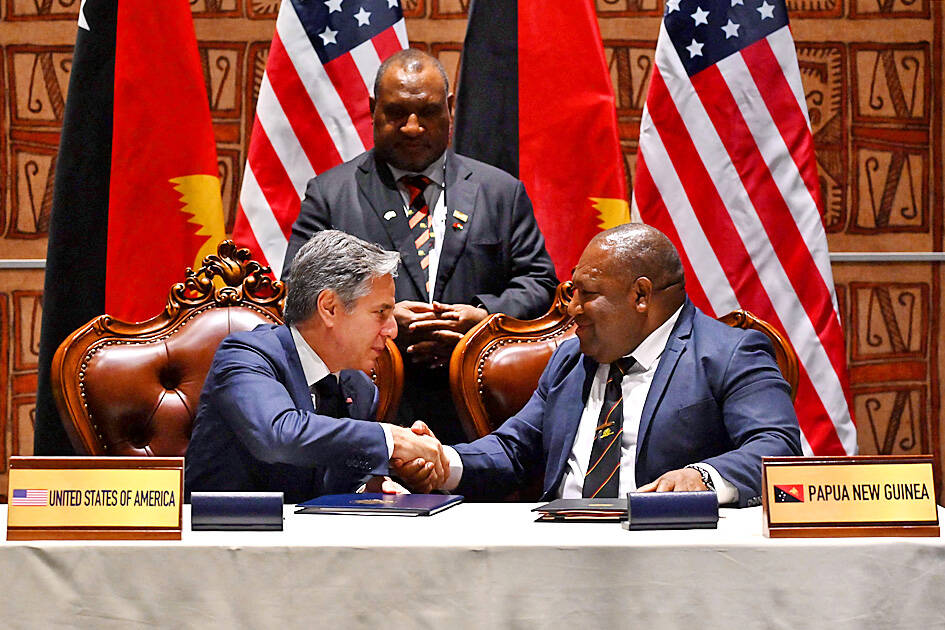The US military can develop and operate out of bases in Papua New Guinea, according to a landmark security pact that is part of Washington’s efforts to outflank China in the Pacific.
The full text of the deal was tabled in Papua New Guinea’s parliament on Wednesday evening and obtained by Agence France-Presse, shedding light on details that have been closely guarded since the pact was signed last month.
With Papua New Guinea’s agreement, the US would be able to station troops and vessels at six key ports and airports, including Lombrum Naval Base on Manus Island and facilities in the capital, Port Moresby.

Photo: AFP
Washington would have “unimpeded access” to the sites to “pre-position equipment, supplies and materiel,” and have “exclusive use” of some base zones, where development and “construction activities” could be carried out.
The agreement opens the door to Washington establishing a new military footprint in the western Pacific, at a time of growing rivalry with Beijing.
Access to Lombrum could be used to reinforce US facilities on Guam to the north, which could be key in the event of a conflict over Taiwan.
Papua New Guinean Prime Minister James Marape has been forced to defend the deal against a wave of protests and criticism, with some opponents questioning whether Papua New Guinea was signing away its sovereignty.
“We have allowed our military to be eroded in the last 48 years,” he told parliament on Wednesday evening. “Sovereignty is defined by the robustness and strength of your military.”
Washington is trying to woo Pacific nations with an array of diplomatic and financial incentives in return for strategic support, after similar moves by Beijing.
The Pacific island nation of Palau has asked the US to step up patrols of its waters after several incursions by Chinese vessels into its exclusive economic zone, Palauan President Surangel Whipps Jr told Reuters in an interview in Tokyo on Wednesday.
Whipps said he would also welcome a bigger US military presence in the country, with troops stationed alongside existing coast guard and civil action teams.
Additional reporting by Reuters

The Central Weather Administration (CWA) yesterday said it expected to issue a sea warning for Typhoon Fung-Wong tomorrow, which it said would possibly make landfall near central Taiwan. As of 2am yesterday, Fung-Wong was about 1,760km southeast of Oluanpi (鵝鑾鼻), Taiwan’s southernmost point, moving west-northwest at 26kph. It is forecast to reach Luzon in the northern Philippines by tomorrow, the CWA said. After entering the South China Sea, Typhoon Fung-Wong is likely to turn northward toward Taiwan, CWA forecaster Chang Chun-yao (張峻堯) said, adding that it would likely make landfall near central Taiwan. The CWA expects to issue a land

Taiwan’s exports soared to an all-time high of US$61.8 billion last month, surging 49.7 percent from a year earlier, as the global frenzy for artificial intelligence (AI) applications and new consumer electronics powered shipments of high-tech goods, the Ministry of Finance said yesterday. It was the first time exports had exceeded the US$60 billion mark, fueled by the global boom in AI development that has significantly boosted Taiwanese companies across the international supply chain, Department of Statistics Director-General Beatrice Tsai (蔡美娜) told a media briefing. “There is a consensus among major AI players that the upcycle is still in its early stage,”

The Central Weather Administration (CWA) yesterday said it is expected to issue a sea warning for Typhoon Fung-wong this afternoon and a land warning tomorrow. As of 1pm, the storm was about 1,070km southeast of Oluanpi (鵝鑾鼻), Taiwan’s southernmost point, and was moving west-northwest at 28 to 32kph, according to CWA data. The storm had a radius of 250km, with maximum sustained winds of 173kph and gusts reaching 209kph, the CWA added. The storm is forecast to pass near Luzon in the Philippines before entering the South China Sea and potentially turning northward toward Taiwan, the CWA said. CWA forecaster Chang Chun-yao (張峻堯) said

Japanese Prime Minister Sanae Takaichi yesterday said that China using armed force against Taiwan could constitute a "survival-threatening situation" for Japan, allowing the country to mobilize the Japanese armed forces under its security laws. Takaichi made the remarks during a parliamentary session while responding to a question about whether a "Taiwan contingency" involving a Chinese naval blockade would qualify as a "survival-threatening situation" for Japan, according to a report by Japan’s Asahi Shimbun. "If warships are used and other armed actions are involved, I believe this could constitute a survival-threatening situation," Takaichi was quoted as saying in the report. Under Japan’s security legislation,